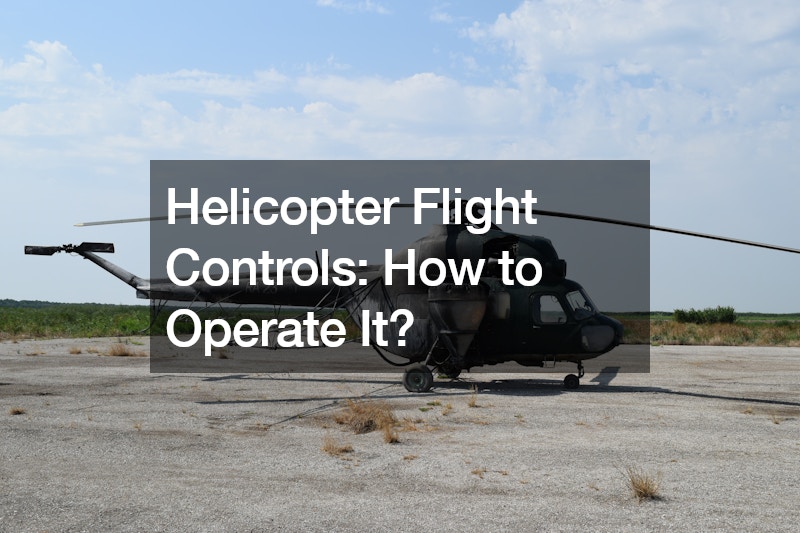
Helicopters are marvels of engineering, offering unparalleled maneuverability and versatility in the skies. However, mastering the art of flying a helicopter requires a thorough understanding of its intricate flight controls. In this comprehensive guide, we will delve into the fundamentals of helicopter flight controls, exploring the components, functions, and techniques essential for operating these remarkable aircraft.
Introduction to Helicopter Flight Controls
Before embarking on the journey of helicopter flight, it is crucial to familiarize oneself with the primary flight controls. Unlike fixed-wing aircraft, helicopters utilize a combination of controls to achieve flight in multiple directions, including vertical takeoff and landing capabilities.
The main flight controls of a helicopter include the collective lever, cyclic stick, and anti-torque pedals, each serving distinct purposes in controlling the aircraft’s movement.
Components of Helicopter Flight Controls
Collective Lever: Located on the left side of the pilot’s seat, the collective lever plays a pivotal role in controlling the helicopter’s vertical movement. By adjusting the collective lever, pilots can vary the pitch angle of the main rotor blades, thus altering the lift generated by the rotor system. Raising the collective lever increases lift, causing the helicopter to ascend, while lowering it decreases lift, facilitating descent.
Cyclic Stick: Positioned in front of the pilot’s seat, the cyclic stick enables control over the helicopter’s lateral and longitudinal movements. Unlike the collective lever, which affects vertical motion, the cyclic stick influences horizontal displacement. By tilting the cyclic stick in different directions, pilots can maneuver the helicopter forward, backward, or sideways, depending on the desired direction of travel.
Anti-Torque Pedals: Situated at the pilot’s feet, the anti-torque pedals control the helicopter’s yaw or rotational motion around its vertical axis. By manipulating the anti-torque pedals, pilots can adjust the pitch of the tail rotor blades, thereby countering the torque produced by the main rotor and enabling directional control. Pressing the pedals left or right causes the helicopter to yaw in the corresponding direction.
Operating the Helicopter Flight Controls
Mastering the operation of helicopter flight controls requires practice, patience, and a thorough understanding of aerodynamics. Here’s a step-by-step guide to operating the primary flight controls of a helicopter:
- Preparation and Familiarization: Before attempting to fly a helicopter, it is essential to undergo comprehensive training and familiarize oneself with the aircraft’s controls and systems. Helicopter flight lessons provide invaluable insights into the principles of flight, cockpit instrumentation, and emergency procedures, laying the groundwork for safe and proficient operation.
- Reading the Operating Handbook: Every helicopter comes with an operating handbook or flight manual containing essential information about the aircraft’s performance characteristics, limitations, and operating procedures. Pilots must diligently study the handbook to gain insights into the specific controls and systems unique to their aircraft model.
- Understanding Basic Controls: Familiarize yourself with the collective lever, cyclic stick, and anti-torque pedals, noting their respective functions and manipulations. Practice operating each control independently to develop muscle memory and coordination.
- Operating the Collective Lever: Use your left hand to manipulate the collective lever, raising it to increase lift and lower it to decrease lift. Understand that adjustments to the collective lever directly affect the pitch angle of the main rotor blades, thereby influencing the helicopter’s altitude.
- Utilizing the Cyclic Stick: Employ your right hand to control the cyclic stick, making subtle adjustments to maneuver the helicopter in different directions. Experiment with the cyclic stick’s responsiveness and sensitivity, maintaining control over the aircraft’s lateral and longitudinal movements.
- Mastering the Anti-Torque Pedals: Coordinate your foot movements to manipulate the anti-torque pedals, controlling the helicopter’s yaw or rotational motion. Practice applying varying amounts of pressure to the pedals to achieve smooth and precise yaw adjustments.
- Maintaining Situational Awareness: Stay vigilant and attentive to the helicopter’s performance, constantly monitoring altitude, airspeed, and heading. Anticipate changes in flight conditions and be prepared to make timely adjustments to the flight controls as needed.
Emergency Procedures
Helicopter pilots must be well-prepared to handle a range of emergency situations that can arise during flight. From mechanical failures to adverse weather conditions, emergencies require quick thinking, decisive action, and adherence to established procedures to ensure the safety of passengers and crew.
One of the most critical emergency scenarios in helicopter aviation is an engine failure. In the event of an engine failure, pilots must immediately initiate the autorotation procedure, a technique that allows the helicopter to descend safely using the energy stored in the rotating blades. Pilots lower the collective to reduce the pitch of the main rotor blades, allowing them to “freewheel” and maintain rotor RPM. Simultaneously, forward airspeed is maintained using the cyclic control to provide lift and control the descent rate. As the helicopter nears the ground, pilots flare the aircraft to reduce the rate of descent before executing a controlled landing.
Conclusion: Navigating the Skies with Confidence
In conclusion, understanding and mastering the operation of helicopter flight controls is a foundational aspect of becoming a proficient pilot. Whether embarking on helicopter flight training or refining existing skills, aspiring aviators must prioritize safety, diligence, and continuous learning. By immersing oneself in the intricacies of helicopter flight controls and embracing the challenges of rotary-wing aviation, pilots can unlock new realms of exploration and adventure in the bound
.




